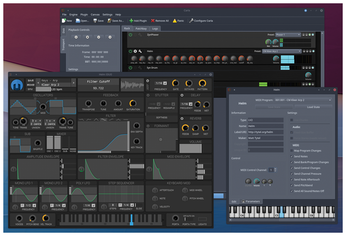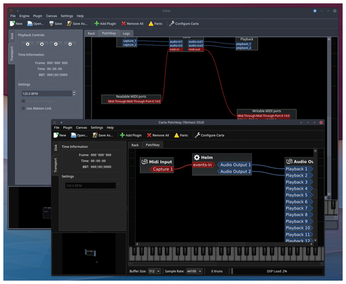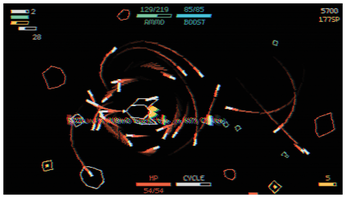FOSSPicks
Carla
The KXStudio project is the curator of some of the best audio and music production utilities on Linux. These utilities are often built to make sense of the Linux audio ecosystem and to provide essential functionality that would otherwise be missing on Linux. The Cadence front-end to JACK, for instance, is the best way of interacting with both JACK and PulseAudio on your Linux desktop. Similarly, Carla is one of the only ways you can host synthesizers and effects on your Linux desktop without having to resort to a full-fledged piece of audio software. This is important because not all audio software can host every kind of plugin – VST3 support is rare, for instance, and you don't always want to instantiate a piece of recording software to play a sound. Carla is the equivalent of a virtual studio, allowing you to load and route audio and MIDI data from any source to any destination. Vitally, all of this works without JACK, which is the normal layer for this kind of functionality on Linux. Carla will work natively with PulseAudio without requiring you to make any sacrifices to the gods of real-time kernels.
The main application uses two main views, and they both lean heavily on the studio metaphor. The first is the rack. This is where you add your plugins, and the audio, or MIDI data, passes through them from the top down to the bottom. Which plugins are available depends on what you have installed. Carla supports more formats than any other application we can think of: LADSPA (including LRDF), DSSI, LV2, VST2 and VST3, plus SF2 and SFZ files for sample playback. There's even an experimental option to enable Wine bridges so that you can include Windows-based plugins natively on your Linux desktop. This breadth of support means you potentially have hundreds of open source and proprietary plugins at your disposal, all of which can be dropped into the rack to create anything from screaming guitar effects via cavernous echo chambers to prog rock synth stacks reaching to the sky. You can open up either the custom GUI for each plugin or the parameter list rendered within Carla. The latter allows you to save your own presets, which extends to the complete collection of plugins you add to the rack so that you can quickly retrieve exactly the same setup if you need to. You can also use this list to assign external MIDI controllers to each parameter, such as a knob or joystick, and even send software controller output to a control voltage device to control external analog synthesizers.
Before you hear anything, you first need to switch to the patchbay. This is the equivalent to the cabling behind the rack and allows you to route your system audio and MIDI into and out of Carla. To hear the output from your rack, for example, connect the audio outputs from the Carla module to the playback module. However, the super-clever aspect to this is that you can add patchbays to the rack and use these and separate, modular, setups to route audio between modules. It's like the Inception of audio solutions. While most users won't need to delve into this complexity, it's an unparalleled feature on any operating system and one of Carla's main strengths. If you've ever wanted to tinker with effects and/or synths without getting into the complexity of a DAW, Carla has to be your go-to choice.
Project Website
https://kx.studio/Applications:Carla


RPG shooter
BYTEPATH
It's perhaps understandable why so many game publishers choose not to release a game's source code after its commercial life has ended. You never know when the retrowave will wash over it and create a new source of revenue. But there's only ever a small chance this will happen, and releasing the source code today can help a whole new generation of game developers to create the games industry of tomorrow. BYTEPATH's developer has taken this pragmatic approach and not only released its source code, but has also published a brilliant tutorial on how the game was created. This takes you from the main game loop and libraries, through gameplay, enemies, and coding practice; it is one of the most comprehensive tutorials we've seen.
The game itself is a unique kind of arcade shooter with a 2D side-view retro-vector style that feels at times like Asteroids, Tempest, and the much later Geometry Wars. What makes BYTEPATH unique is a crazily large and complex skill tree that allows you to control how your skills are upgraded. You start off by selecting your character/ship. Each ship has a different class tree and abilities, and these equate to different low-level presets in the skill tree, which can then be augmented with skill points (SP). You're given an amount of SP at the start, but you collect more when you're inside the shooter element of the game. This sees you flying through space, collecting debris, SP, and upgrades while shooting things, and hopefully lasting long enough to collect the keys required to finish. The entire game is rendered through what feels like a broken terminal filter. It also features some beautiful 8-bit style music to go along with the visuals. Written in Lua with the LÖVE game engine, the code has been released under MIT, with varying licenses for media. It's both a brilliant game and an important open source project.
Project Website
https://github.com/a327ex/BYTEPATH

Buy Linux Magazine
Subscribe to our Linux Newsletters
Find Linux and Open Source Jobs
Subscribe to our ADMIN Newsletters
Support Our Work
Linux Magazine content is made possible with support from readers like you. Please consider contributing when you’ve found an article to be beneficial.

News
-
TUXEDO Computers Unveils Linux Laptop Featuring AMD Ryzen CPU
This latest release is the first laptop to include the new CPU from Ryzen and Linux preinstalled.
-
XZ Gets the All-Clear
The back door xz vulnerability has been officially reverted for Fedora 40 and versions 38 and 39 were never affected.
-
Canonical Collaborates with Qualcomm on New Venture
This new joint effort is geared toward bringing Ubuntu and Ubuntu Core to Qualcomm-powered devices.
-
Kodi 21.0 Open-Source Entertainment Hub Released
After a year of development, the award-winning Kodi cross-platform, media center software is now available with many new additions and improvements.
-
Linux Usage Increases in Two Key Areas
If market share is your thing, you'll be happy to know that Linux is on the rise in two areas that, if they keep climbing, could have serious meaning for Linux's future.
-
Vulnerability Discovered in xz Libraries
An urgent alert for Fedora 40 has been posted and users should pay attention.
-
Canonical Bumps LTS Support to 12 years
If you're worried that your Ubuntu LTS release won't be supported long enough to last, Canonical has a surprise for you in the form of 12 years of security coverage.
-
Fedora 40 Beta Released Soon
With the official release of Fedora 40 coming in April, it's almost time to download the beta and see what's new.
-
New Pentesting Distribution to Compete with Kali Linux
SnoopGod is now available for your testing needs
-
Juno Computers Launches Another Linux Laptop
If you're looking for a powerhouse laptop that runs Ubuntu, the Juno Computers Neptune 17 v6 should be on your radar.

